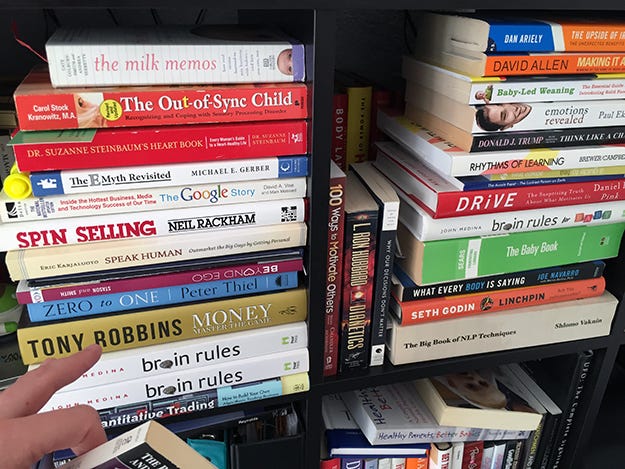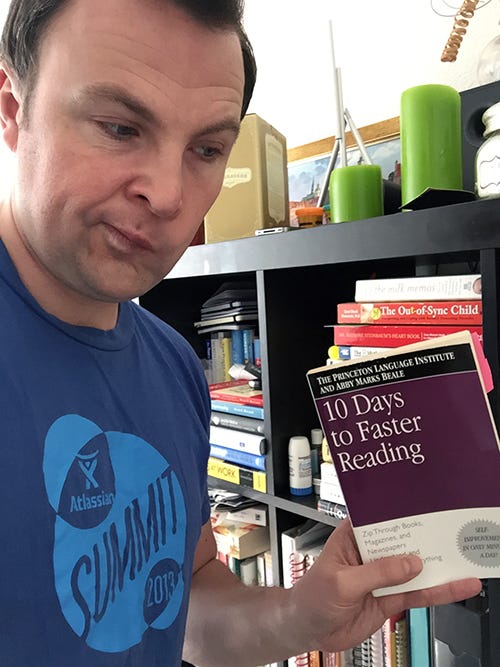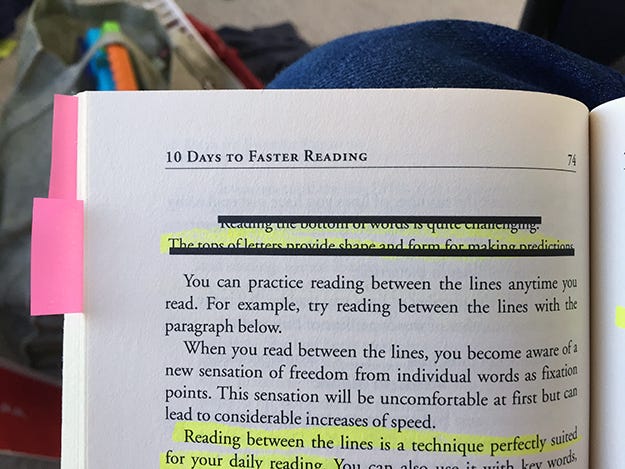How to Read 500 Words Per Minute
How I went from 300 words per minute (wpm) to 480 wpm in 10 Days
I started at 300 wpm (words per minute) with 80% comprehension and by the end of the book was up at 480 wpm with eighty% comprehension. Inspired past Nib Gates knocking over at to the lowest degree one — 2 books per week, I prepare out to achieve my own feat, and here's how y'all too tin can achieve information technology.
ten Days to Faster Reading: How I went from 300 wpm (words per minute) to 480 wpm https://t.co/I2NyL97wjY #TRTSV picture show.twitter.com/DvA3mkJW2F
— Ernest Semerda (@ernestsemerda) Jan 31, 2016

So this is the way I see information technology:
More than Books => Faster Reading == Meliorate Comprehension => More Blogging
Then Casey Neistat reminded me of something Seneca said about fourth dimension and how nosotros utilise information technology:
"It is not that we have a brusk time to alive, but that we waste a lot of it. Life is long enough, and a sufficiently generous amount has been given to us for the highest achievements if it were all well invested." ~ Seneca
I recollect I can exercise this!
BIG opportunity. Recall dorsum to what life was similar just 100 years ago where only the distinguished and affluent had access to noesis. Now we all do. If merely we had more time. There is a style non involving Einstein's Relativity.
"The road to knowledge begins with the turn of a page."
Dorsum to Basics
We all know foundational skills are important. A house without foundation is a sitting duck. What if what I learnt at school was wrong. Or out of appointment with modern times. Or not plenty. It was fourth dimension to go dorsum to basics of reading and notice out what I could do better when reading. So I picked up a volume by The Princeton Linguistic communication Institute and Abby Marks Beale called x Days to Faster Reading. Fitting title for what I wanted to achieve. The book starts crushing schoolhouse fallacies. They include "you have to read every word", "hear the sound out words in your head", "don't skim, that'due south cheating", "you need to completely sympathize everything y'all read". Ok book, you lot have my attention.

Setting the Base
What does an boilerplate reader actually look like? They read at 200–300 words per minute (wpm)
- 100–200 wpm: Slow reader — move their lips and probably read to themselves
- 200–300 wpm: Average reader — whisper when they read
- 300–400 wpm: Good reader — may talk a little when they read but not as much equally average reader
- 400–500 wpm: Above boilerplate reader
Humans talk at 100–150 words per minute.
Humans Retrieve upward of 400 words per minute.
What happens to the delta? Well, that's your wondering brain as you read. Hence, why ho-hum readers sometimes fall asleep while reading.
Expert comprehension
Reading speed alone isn't enough. Skilful comprehension is also required. Practiced comprehension falls between 70–xc%. If your comprehension is below the 70% then yous need to work on your vocabulary.
Your comprehension is better than you think. We underestimate our abilities. The encephalon works in mysterious ways. Thus, you should TRUST your brain more and believe that y'all are capable of better comprehension.
The 3 about common passive reading habits:
- Mind wandering
- regression and
- subvocalization
Information technology is impossible to eliminate them. But you tin can reduce them. First by becoming aware of their presence and then by learning to read fast while trusting your comprehension. i & 3 can be reduced past using techniques to read fast. Retrieve that you lot brain works at a faster footstep. Don't give it the delta to wander around (ie. twenty-four hours dreaming). And 2 trust your mind that information technology understood the context of the bulletin. Opposite to what you were taught, you don't demand to read word by word.
Techniques to Faster Reading
What I plant useful throughout the book is the end of chapter tests. Each chapter introduces you lot to a technique with wisdom followed by a reading test. You should do the reading test. Information technology provides y'all with the quantitive data on your reading speed and comprehension. This played a role in giving me confidence I could do this. Goodbye one-time school fallacies.
"Your encephalon is prewired to learn linguistic communication. Simply not reading. Learning to read faster is like understanding how to decode words in a more efficient way."
Technique 1: Pacers
Use your hand, a pen or a blank white card to increase your reading speed. These are called Pacers. Think of a pacer equally a stick shift. Pacers force the eyes to move in a directed pattern downwardly the page to help y'all get up to speed. Pacers function like a footstep machine in a race. You know, that 1st car which guides the remainder effectually the track to a sure speed before moving out of the way.
The full general rules for whatsoever pacer is:
Go along your pacer moving down the folio not across and Do not stop or become back.
A finger as a pacer is besides ok.
Technique 2: Widen your Rail
To read fast you need to see more than words. Admission your peripheral vision. You lot don't need to be focused on one give-and-take at a time. Phase Flashing is a ways of grouping words together into thoughts. The book has a technique there to teach you this called The Eye Span Pyramid. Give it a shot. Even if its just to see how married woman your peripheral vision is.
Technique three: Concentrate, Focus!
Focus. Find a quiet identify where y'all can concentrate. Reading in bed won't work. You sleep in bed. You lot will quickly drift away there. Anything lying down is going to put you to sleep. Cut off all distractions similar background music. You also need to be sitting up to stay awake. Ever tried to meditate while laying in bed? Yes you fall comatose pretty fast.
I found the library is a perfect place to concentrate. It is quiet and has a purpose for studying/reading. It has that energy effectually it that it'southward what people do there and forces you to concentrate and read while sitting up. If you need a tool to help you focus on 1 matter at a time then take a peek at GSDfaster'southward Pomodoro Technique. It uses a timer to aid you focus on 1 thing for a menstruum of fourth dimension. Sitting down for hours frequently breaks your focus. This mode you group your reading into periods of 30 minute intervals with breaks between. No burnouts.
Technique 4: Take a Purpose
This is more powerful than you might realize at outset. Ask yourself:
"WHY am I reading this?" and
"WHAT might I need this information for?"
This is a powerful motivator. It helps you uncover your purpose and responsibility. It literally says: this is important. It must exist done. It'due south like a personal trainer. If something isn't important so it can exist done at any footstep and at any time. The WHY and WHAT set a level of importance and urgency.
Technique 5: Reading Betwixt the Lines
Speed up your reading and comprehension past stopping on the white space just above each line. Not on the line of print.
Example — meet pic below; which is easier to read?

"Faster reading and so becomes a tool to assistance you get the comprehension you want."
There are other techniques in the book you might want to explore. The ones I mentioned to a higher place resonated with me and helped me hit the 400 wpm marker.
Turbo Comprehension: Getting to the Gist
It'south no use reading fast if you lot cannot empathize what you just read. The context. The score in the book states that anyone with <70% comprehension lacks vocabulary. Meliorate comprehension is proportional to the breath of your English vocabulary.
Hither are 2 useful techniques:
1. Use the 5Ws and H: Who, What, When, Where, Why and How. Pre-View or read looking for these to requite you context. These clues will give you most 40% of the central information. The remaining 60% is filler, fluff or explanation.
2. Expand your Vocabulary. The more words you know the improve. When you lot come beyond a give-and-take you don't understand reach for the dictionary and learn it. A Dictionary is a great tool to acquire new vocabulary. Specially if English is not your 1st language. The more words you know the easier it is to not only read faster but also with slap-up comprehension. Comprehension takes 3 forms — Literally, Interpretively and Applied. Make sure your comprehension spans all 3. The book has nifty examples on these.
"It takes time to save fourth dimension."
End of Chapter: Time Trial
The book has time trials at the end of each affiliate to exam your words per infinitesimal (wpm) and comprehension. At showtime, I was resistant but soon I became a convert and found this section super useful. In that location is nothing like tracking and comparing progress. Especially if it improves and yous start seeing the value in what yous are learning. So how did I perform? Better than I imagined. I started at 300 words per minute (wpm) at 80% comprehension and finished up on 480 wpm.
If interested, you tin can find my score bill of fare (quantitive information on my progress) on my personal blog here http://www.theroadtosiliconvalley.com/book-reviews/howto-x-days-faster-reading-480-wpm/. Now that I have quantitive data, I tin can make meliorate decisions. Furthermore, this excercise has inverse how I felt about my reading ability, speed, and comprehension. I am now more than positive about my reading ability. A win!
My peak 3 takeaways
- Trust my brain that information technology will understand (comprehend) what I read.
- Utilise a pacer to keep my optics and listen focused on content.
- It is ok to skim. Ref indicate #1.
Final note. Reading 10 Days to Faster Reading alone is not enough. You need to participate in the stop of chapter exercises and then practice vigorlously. The volume is a wealth of knowledge breaking down old barriers and giving you tools you lot wish you had earlier in life.
Happy reading!
~ Ernest
Volume mentioned in the blog mail service: 10 Days to Faster Reading by The Princeton Language Establish and Abby Marks Beale.
This post was 1st published on Ernest's weblog The Road to Silicon Valley: http://www.theroadtosiliconvalley.com/book-reviews/howto-10-days-faster-reading-480-wpm/
livengoodclee1960.blogspot.com
Source: https://medium.com/the-road-to-silicon-valley/how-i-went-from-300-words-per-minute-wpm-to-480-wpm-in-10-days-ccf2013dd814
0 Response to "How to Read 500 Words Per Minute"
Post a Comment